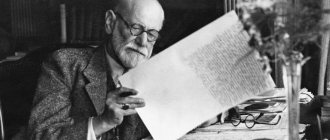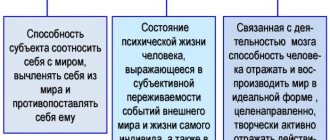Structure of consciousness
The work of consciousness is aimed at understanding the surrounding world and processing incoming information. These two processes allow consciousness to form its own picture of the world and attitude towards one or another aspect of the universe. In order to be able to form a holistic concept of something, consciousness must have a multidimensional structure, including tools of perception and analysis, memory, levers of influence and self-expression.
In the structure of consciousness, five spheres are conventionally distinguished:
- Intelligence, the core of which is knowledge;
- Motivation, the basis of which is the desire for an internal ideal - a goal;
- Will - the ability to create mental effort to achieve a goal;
- Emotions or experiences are subjective attitudes towards the objective world;
- Self-awareness or self-identification.
How does the activity of consciousness manifest itself?
Consciousness is the part of the psyche responsible for attention, reasoning, the ability to think rationally and make logically correct decisions. It is entrusted with control over the daily actions of a person performed voluntarily ; it processes commands sent to us by our mind. In addition, consciousness is entrusted with the task of maintaining communication between the individual and the world around him, as well as the function of establishing interaction with the inner “I” of each of us.
Consequently, consciousness is a product of the activity of the brain, which allows it to control the attention of the individual. At the same time, the control itself can be carried out both consciously (for example, a person consciously squints to look at an object located in the distance) and unconsciously, at the subconscious level (when people involuntarily squint from too bright illumination).
The work of consciousness. Process and principle
The structure of human consciousness is manifested in the process of cognition of the surrounding world - the environment. Entering consciousness from the environment, information evokes emotions and experiences in us, and we form our personal, emotionally charged attitude towards an aspect of reality. Emotions become the basis for the emergence of desires to repeat pleasant experiences or never repeat what was unpleasant to us. Thus, the essence of consciousness also lies in selectivity. Not all objects and phenomena of the surrounding reality find their place in a person’s consciousness, but only those that are currently relevant for him.
The nature of emotions and most desires are instincts that lie in the subconscious, allowing the entire natural world to survive in a changing environment.
For example, almost everyone tries chocolate for the first time once. As a rule, a person likes the taste of chocolate, and he has a desire to repeat this pleasant sensation again. If we taste something bitter, we will probably have the desire to never taste it again.
At the same time, a desire can remain just a desire if it does not have the proper motivation for implementation. Such motivation can be an urgent need.
For example, an aborigine living in a tropical climate, accustomed to wearing a loincloth, may have a desire to have the garment if it is shown to him and its practical use explained to him. However, his motivation to obtain these clothes in mild climatic conditions will be much less than that of a resident of a continental climate with winter cold.
If a person’s motivation is sufficient, his desire can turn into a goal. And with the help of willful efforts, this goal can be achieved.
An integral element in the structure of consciousness, which allows one to analyze incoming information and try it on with one’s already existing picture of the world, is intelligence . With the help of intelligence, we acquire knowledge and skills that can later be used to achieve our goals.
Self-consciousness is another important element in the structure of consciousness, which mainly distinguishes man from animals. Self-awareness is the ability to turn the vector of knowledge towards oneself. Receiving information from the outside, a person draws conclusions about his own place in the world around him, about his qualities and abilities. Self-identification of consciousness with some element of one’s “I” appears. Any characteristic you can give yourself is an identification. For example: a parent, an economist or a happy person. It is self-awareness that allows us to answer the question “who am I.”
The concept of the unconscious.
The unconscious is a set of mental processes and phenomena that are not included in the sphere of consciousness of the subject (person), i.e. for which there is no control of consciousness.
The concept first appeared in the days of Ancient Greece, when the philosopher Plato developed the doctrine of cognition-memory. This is how the general idea of definition arose, which did not undergo significant changes until the advent of modern times. The first concept was proposed by Leibniz in 1720. He believed that the unconscious is the lowest form of mental activity.
The famous Austrian psychologist Sigmund Freud began a serious study of this issue. In the course of his activities, he began to carry out experimental development of the concept of the unconscious. In the psychology of that time, it was generally accepted that this term meant many actions, the implementation of which a person is not fully aware of. This meant that certain decisions were not conscious. Freud understood the meaning of the concept as the repression of our secret desires and fantasies that contradict established norms of public morality and norms of behavior. In addition, according to the psychologist, such actions and decisions in reality were too disturbing for the individual, and therefore he preferred that they not be conscious.
In short, the psychology of the unconscious in his understanding clearly correlated with the fact that the main regulator of human behavior from time immemorial has been the desires and drives of individuals. The doctor noted that completely unconscious experiences can have a significant impact on the quality of life. Due to such internal conflict, various neuropsychiatric diseases may well develop. Freud began to look for a solution that could help his patients. Thus, his own method of healing the soul called “psychoanalysis” was born.
The main problem for people with these experiences is considered to be the lack of subjective control. The unconscious in psychology or the subconscious denotes such mental processes that cannot be reflected in the consciousness of the individual, that is, they are absolutely not controlled by his will. Among the main types of manifestations are those presented in the list below.
- Unconscious motivation or urge to action. The real meaning of the act is not accepted by the individual for some reason, for example, public and social unacceptability, internal contradictions or conflicts with other motives.
- Supraconscious processes. These include creative insight, intuition, inspiration and other similar manifestations.
- Atavisms and behavioral stereotypes. They manifest themselves for the reason that they have been worked out by the individual to the point of complete automaticity, and therefore do not require awareness if the situation is familiar.
- Subliminal perception. It implies the presence of a large amount of information, which is why it cannot be fully comprehended.
Carl Gustav Jung continued to study the issue after Freud. Based on the definition of the unconscious as a subject of psychology, he created an entire separate discipline - analytical psychology. In comparison with interpretations in psychoanalysis, the theoretical framework and speculations based on it have been significantly expanded. In particular, a division into new classes has appeared. Jung distinguished between the personal or individual unconscious and the collective unconscious.
The last definition implied the possibility of filling archetypes with any content. By default, the collective unconscious carried empty forms, otherwise called proformas. The individual part, in turn, had information about the mental world of an individual person. According to Jung, the personal unconscious had an attractive influence on the individual’s consciousness, but did not assimilate it.
The ideas of Freud and Jung made it possible to expand the understanding of the concept through the efforts of the Italian psychologist and psychiatrist Roberto Assagioli. Based on the expert's conclusions, a new discipline emerged - psychosynthesis. The researcher presented in his work three main levels that demonstrate the unconscious in human psychology.
- Lower. This level refers to the simplest forms of mental activity. With their help, the individual controls his own body, manias, phobias, desires, dreams, complexes, drives and impulses.
- Average. The main content is considered to be all elements that freely penetrate into consciousness in a person’s waking state. The purpose of the middle level of the unconscious is to develop mental activity, increase the possibilities of fantasy and assimilate the experience gained.
- Higher. Also called the superconscious level. Roberto believed that human heroic aspirations, intuition, contemplation, inspiration and altruism are manifested here.
The general characteristics of the relationship between the conscious and the unconscious today have become much more transparent than it was during the lifetime of the scientific minds who first tried to describe such connections. The study of consciousness and the unconscious in psychology has advanced greatly thanks to the use of modern technologies, which have shed light on many processes occurring in the human brain. For example, it has been scientifically proven that an individual is able to make decisions due to the presence of certain acquired information that was not conscious to him to any extent.
Theories about human consciousness
The nature and fundamentals of the functioning of consciousness have always occupied an important place in the research conducted by scientists and in the theories they put forward. Let's look at the most popular of them:
- The theory of dualism is built on the existence of two substances: consciousness itself and physical objects (thus, Plato already attributed the human body to the material world, and considered the soul to belong to the world of ideas). However, dualism was formulated into an independent theory by R. Descartes, who contrasted the spiritual with the material and, on the basis of this judgment, separated soul and body. Descartes considered human consciousness to be the only phenomenon whose existence cannot be doubted. At the same time, dualists were unable to explain exactly how interaction occurs between such incompatible spheres: spiritual and material.
- The theory of logical behaviorism is based on the denial of the dualism of the spiritual and material spheres. Proponents of this concept consider consciousness to be ordinary behavior, and memories, thoughts, as well as the spheres of perception and expectations are considered factors of behavior.
- Idealism not only recognizes the fact of the existence of consciousness, but also denies any possibility of the existence of physical objects independent of consciousness, thinking and perception. One of the proofs of this statement is the following aspect: there is no way that could experimentally confirm the existence of at least one physical object located beyond the boundary of human perception.
- Materialism is based on the statement about the physical nature of everything that exists. For this reason, materialists attribute consciousness to a physical object, consisting, like everything else, of highly organized matter.
- Functionalism is a relatively new theory that emerged in the last decades of the 20th century. Its supporters believe that a person’s mental state is entirely dependent on the functions assigned to him, and consciousness is one of these functions.
The concept of consciousness in psychology
From the point of view of psychology, consciousness is the ability to reflect on oneself, one’s actions and the surrounding world, which is the highest mental function.
That is, I know that I am me, and you are you. I see the cause-and-effect relationships of events and phenomena, and if I don’t see them, then I can imagine them abstractly and fantasize.
I can feel my body, be aware of the feelings and emotions that belong to me. I even know how to broadcast all this through speech, facial expressions and gestures (verbal and non-verbal).
How is consciousness different from the subconscious?
But what controls us in a dream, when consciousness is inactive? At this time, the control of physiological processes is carried out by our subconscious, acting without the consent and approval of a person. The main difference between the subconscious and consciousness is the fact that the subconscious is always active, it functions continuously throughout human life, manifesting itself especially clearly at night in the form of dreams. But people do not notice the work of the subconscious, which is why many do not believe in its existence at all, making a huge mistake.
The subconscious and consciousness have few common features; they are united only by the fact that both the first and second concepts are classified as components of the human mind, but there are much more differences between them. Let's list them:
- The main difference between them lies in the functions that regulate the subconscious and consciousness. Thus, the consciousness is assigned control over logic, intelligence, communication, decision-making ability, etc., and the main function of the subconscious is control over physiological functions, for example, breathing, as well as over a person’s emotions, feelings and beliefs;
- To activate the subconscious, it needs information previously received by the individual; it is this information that the subconscious reproduces and brings to the level of consciousness. In contrast, consciousness is capable of perceiving and analyzing information from the outside;
- Another difference between these terms was the presence of a thought process. Consciousness is impossible without thinking , while subconscious activity does not require the connection of thought processes to it.







